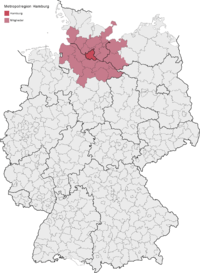Hamburg Metropolitan Region
| Hamburg Metropolitan Region Metropolregion Hamburg | ||
|---|---|---|
| ||
 location of the Hamburg Metropolitan Region in Germany | ||
| Country |
| |
| States |
| |
| Largest Cities | Hamburg | |
| Area | ||
| • Metro | 26,000 km2 (10,000 sq mi) | |
| Population [1] | ||
| • Metro | 5,100,000 | |
| • Metro density | 192/km2 (500/sq mi) | |
| Time zone | CET (UTC+1) | |
| Website | http://www.metropolregion.hamburg.de/ | |
The Metropolregion Hamburg (German for Hamburg Metropolitan Region) is the compilation of eight districts in the German federal state of Lower Saxony, six districts in Schleswig-Holstein, two districts in Mecklenburg-Vorpommern and the city-state of Hamburg in northern Germany. It covers an area of ca 26,000 square kilometres (10,000 sq mi), and is home to more than 5.1 million inhabitants.
History
On 1 January 2006, the office of the Hamburg metropolitan region opened, as agreed in a state treaty of cooperation (Staatsvertrag über Zusammenarbeit) between Hamburg, Lower Saxony and Schleswig-Holstein.[2]
Geography
In 2005, the Hamburg metropolitan region consisted of the city-state Hamburg, rural districts of Lower Saxony, and districts of Schleswig-Holstein, with more than 800 cities, towns or municipalities. The region covered an area of 19,802 square kilometres (7,646 sq mi).[3] It was later extended with an area of the Ludwigslust-Parchim district and the Nordwestmecklenburg district of Mecklenburg-Vorpommern.
|
States and districts
|
Largest cities and towns
| ||||||||||||||||||||||||||||||||||||||||||||||||||||||||||||||||||||||||||||||||||||||||||||||||||||||||||||||||||||||||||||||||||||||||||||||||||||||||||||||||||||||||||||||||||
* Districts and District free cities (German: Kreisfreie Städte).
† Ludwigslust was merged into Ludwigslust-Parchim in 2011; pop. data for 2010
Larger Urban Zones


The Hamburg Larger Urban Zone (LUZ) as defined by Eurostat's Urban Audit covers an area of 7,303 km² and in 2004 contained 3,134,620 inhabitants[6] (pop. density 429/km²). The Larger Urban Zone covers the Free and Hanseatic city of Hamburg and only the directly bordering districts:[7] The Hamburg LUZ corresponds with the service area of Hamburger Verkehrsverbund (HVV). only in these areas, the population density is 150 inhabitants/km2 or higher.
| State | District* | Population (2012) |
Area |
Pop. density (2012) |
|---|---|---|---|---|
| | – | 1,813,587 | 755 km2 | 2,400/km2 |
| | Harburg | 239,269 | 1,245 km2 | 190/km2 |
| Stade | 195,606 | 1,266 km2 | 150/km2 | |
| | Lauenburg | 187,905 | 1,263 km2 | 150/km2 |
| Pinneberg | 298,826 | 664 km2 | 450/km2 | |
| Segeberg | 261,988 | 1,334 km2 | 200/km2 | |
| Stormarn | 232,911 | 766 km2 | 300/km2 | |
| Hamburg LUZ[8][9] | 2,903,198 | |||
| | Lübeck | 211,713 | 214.13 km2 | 990/km2 |
| Ostholstein | 197,882 | 1,391 km2 | 140/km2 | |
| Lübeck LUZ[8][9] | 391,373 | |||
| | Bremerhaven† | 112,895 | 78,87 km2 | 1,400/km2 |
| | Cuxhaven | 198,115 | 2,073 km2 | 96/km2 |
| Bremerhaven LUZ[8][9] | 288,635 | |||
* Districts and District free cities (German: Kreisfreie Städte).
† not part of the Hamburg Metropolitan Region
 Hamburg City Hall (Rathaus), seat of the Hamburg Senate
Hamburg City Hall (Rathaus), seat of the Hamburg Senate
 Lübeck's seaside resort Travemünde
Lübeck's seaside resort Travemünde
 Wismar, World Heritage old town
Wismar, World Heritage old town
See also
References
- ↑ "Hamburg" (in German). Retrieved 12 June 2009.
- ↑ Impressum - metroploregion Hamburg (in German), retrieved 25 March 2009
- ↑ Hamburg Metropolitan Area fact sheet (PDF), Statistical office Hamburg and Schleswig-Holstein (Statistisches Amt für Hamburg und Schleswig-Holstein), 2006, retrieved 25 March 2009
- ↑ Bevölkerungsstand und Bevölkerungsdichte am 31.12.2012, Metropolregion Hamburg, 2013
- ↑ Flächennutzung: Siedlungs- und Verkehrsfläche nach Art der tatsächlichen Nutzung am 31.12.2012, Metropolregion Hamburg, 2013
- ↑ "Hamburg". Archived from the original on 15 July 2011. Retrieved 15 June 2009.
- ↑ http://www.staedtestatistik.de/508.html Retrieved 15 June 2009.
- 1 2 3 Population by larger urban zone, eurostat, 2014
- 1 2 3 Map of metro regions, eurostat, 2012
External links
- Metropolregion Hamburg - official webpage
Coordinates: 53°30′N 10°00′E / 53.5°N 10.0°E
